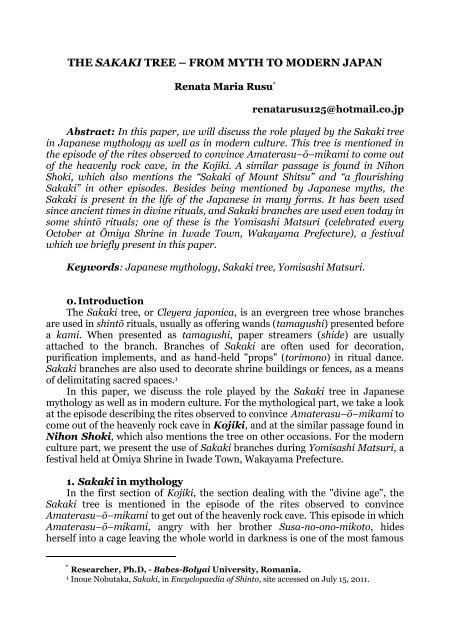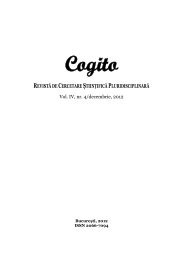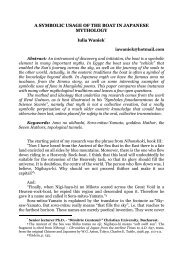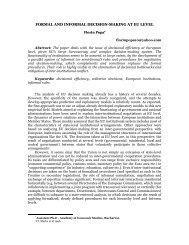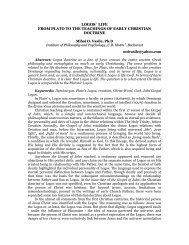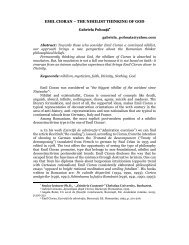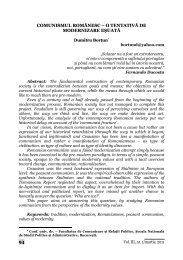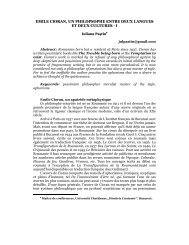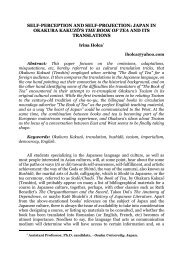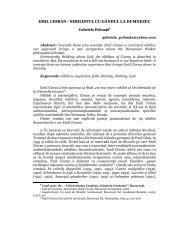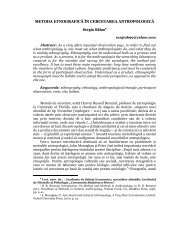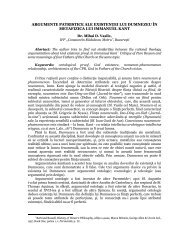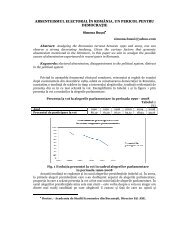THE SAKAKI TREE â FROM MYTH TO MODERN JAPAN - cogito
THE SAKAKI TREE â FROM MYTH TO MODERN JAPAN - cogito
THE SAKAKI TREE â FROM MYTH TO MODERN JAPAN - cogito
Create successful ePaper yourself
Turn your PDF publications into a flip-book with our unique Google optimized e-Paper software.
<strong>THE</strong> <strong>SAKAKI</strong> <strong>TREE</strong> – <strong>FROM</strong> <strong>MYTH</strong> <strong>TO</strong> <strong>MODERN</strong> <strong>JAPAN</strong>Renata Maria Rusu renatarusu125@hotmail.co.jpAbstract: In this paper, we will discuss the role played by the Sakaki treein Japanese mythology as well as in modern culture. This tree is mentioned inthe episode of the rites observed to convince Amaterasu–ō–mikami to come outof the heavenly rock cave, in the Kojiki. A similar passage is found in NihonShoki, which also mentions the “Sakaki of Mount Shitsu” and “a flourishingSakaki” in other episodes. Besides being mentioned by Japanese myths, theSakaki is present in the life of the Japanese in many forms. It has been usedsince ancient times in divine rituals, and Sakaki branches are used even today insome shintō rituals; one of these is the Yomisashi Matsuri (celebrated everyOctober at Ōmiya Shrine in Iwade Town, Wakayama Prefecture), a festivalwhich we briefly present in this paper.Keywords: Japanese mythology, Sakaki tree, Yomisashi Matsuri.0.IntroductionThe Sakaki tree, or Cleyera japonica, is an evergreen tree whose branchesare used in shintō rituals, usually as offering wands (tamagushi) presented beforea kami. When presented as tamagushi, paper streamers ( shide) are usuallyattached to the branch. Branches of Sakaki are often used for decoration,purification implements, and as hand-held "props" ( torimono) in ritual dance.Sakaki branches are also used to decorate shrine buildings or fences, as a meansof delimitating sacred spaces. 1In this paper, we discuss the role played by the Sakaki tree in Japanesemythology as well as in modern culture. For the mythological part, we take a lookat the episode describing the rites observed to convince Amaterasu–ō–mikami tocome out of the heavenly rock cave in Kojiki, and at the similar passage found inNihon Shoki, which also mentions the tree on other occasions. For the modernculture part, we present the use of Sakaki branches during Yomisashi Matsuri, afestival held at Ōmiya Shrine in Iwade Town, Wakayama Prefecture.1. Sakaki in mythologyIn the first section of Kojiki, the section dealing with the "divine age", theSakaki tree is mentioned in the episode of the rites observed to convinceAmaterasu–ō–mikami to get out of the heavenly rock cave. This episode in whichAmaterasu–ō–mikami, angry with her brother Susa-no-ono-mikoto, hidesherself into a cage leaving the whole world in darkness is one of the most famous Researcher, Ph.D, - Babes-Bolyai University, Romania.1Inoue Nobutaka, Sakaki, in Encyclopaedia of Shinto, site accessed on July 15, 2011.
episodes in Japanese mythology. “Owing to this, eternal night prevailed” 2 says theKojiki, and according to the Nihon Shoki, “…constant darkness prevailed onall sides, and the alternation of night and day was unknown” 3 .The story goes like this: the divine couple, Izanagi and Izanami, gave birthto the Japanese islands and to many kami. Their daughter, Amaterasu–ō–mikami, born from the left eye of her father, became the celestial sun goddessfrom whom the Japanese imperial family claims descent. Her brother Susanoo,the storm god, was sent to rule the sea. But before going, Susanoo destroyed therice fields, defiled his sister's dwelling, and threw a flayed horse through herweaving hall. Indignant, Amaterasu–ō–mikami withdrew to a rock cave andfastened the rock door, plunging the world into darkness. Eight hundred othergods gathered and conferred on how to lure the sun goddess out in order torestore the cycle of night and day. So the gods dug up a 500-branched Sakaki treefrom the heavenly Mount Kagu; on its upper branches they hung an eight-footstring of 500 jewels, on its middle branches an eight-foot long mirror, and on itslower branches were placed white and blue offerings. Then came Ame-no-uzumeno-mikoto(Her-Augustness-Heavenly-Alarming-Female) and using club mossas a sash, branches from the Sakaki as a headdress, and leaves of bamboo grassas a posy, she performed a provocative dance, which delighted the assembledgods so that they roared with laughter. Amaterasu–ō–mikami, curious aboutwhy the gods could be so merry when the world was plunged in darkness and toldthat outside the cave there was a goddess more illustrious than she, peeked out ofthe cave and saw her reflection in the mirror hanging from the Sakaki. Entrancedby the sight, she was drawn out of the cave and the gods quickly threwa shimenawa – a sacred rope of rice straw – in front ot the rock door, to preventher return to hiding. Thus, light was restored to both the heavens and the earth.Let us look at how the story is told in the Kojiki first:“So thereupon the Heaven-Shining-Great-August-Deity,terrified at the sight, closed [behind her] the door of the HeavenlyRock-Dwelling, made it fast, and retired, Then the whole Plain ofHigh Heaven was obscured and all the Central Land of Reed-Plainsdarkened. Owing to this, eternal night prevailed. Hereupon thevoices of the myriad Deities were like unto the flies in the fifthmoon as they swarm and a myriad portents of woe arose.” 4Takamitsu Kōnoshi points out the fact that although this episode takesplace in the Plain of High Heaven, it seems to be self-evident that the CentralLand of Reed-Plains is also affected. 5 And later, when Amaterasu–ō–mikami isout of the cave, “both the Plain of High Heaven and the Central-Land-of-Reed-2Basil Hall Chamberlain (trans.), The Kojiki. Records of Ancient Matters, Boston, TuttlePublishing, 1981, p. 64.3W.G. Aston (trans.), Nihongi. Chronicles of Japan from the Earliest Times to A. D. 697,Boston, Tuttle Publishing, 1972, p. 41.4Basil Hall Chamberlain (trans.), op. cit., pp. 64 – 65.5Takamitsu Kōnoshi, Kojiki to Nihonshoki. ‘Tennōshinwa’ no rekishi, Tōkyō, KōdanshaGendaishinsho, p. 100.
Plains of course again became light.” 6 This means that Amaterasu–ō–mikamiinfluences both worlds, proving a strong relation between the world of the godsand the world of the humans. On the temporal aspect, both mythological recordsemphasize the unchanging condition of darkness, although there is no hint oftime coming to an end. 7What happens in this myth is that the principle of kegare (impure, unclean)becomes predominant, making it necessary for certain rites to be performed, sothat the ke 8 (ordinary, mundane, everyday life) can be restored. In this context,the role and the description of the Sakaki in this myth are very interesting. Thepassage in the Kojiki states that "they tore from the very roots theflourishing masakaki of the mountain Ame no Kaguyama," andfestooned it with jewel beads, a mirror, and cloth (nigite). The Sakakiis called “the true” tree and it is said to have five hundred branches, whichbecome the support of the various sacred objects – the jewels, the mirror, theblue and the white offerings. Then, “liturgies” are recited in the presence of thetree, clearly showing that some king of religious manifestations were associatedwith it.“Hereupon the voices of the myriad Deities were like unto theflies in the fifth moon as they swarm and a myriad portents of woearose. Therefore did the eight hundred myriad Deities assemble ina divine assembly in the bed of the Tranquil River of Heaven, andbid the Deity Thought-Includer, child of the High-August-Producing-Wondrous-Deity think of a plan, assembling the longsingingbirds of eternal night and making them sing, taking thehard rocks of Heaven from the river-bed of the Tranquil River ofHeaven, and taking the iron from the Heavenly Metal-Mountains,calling in the smith Ama-tsu-ma-ra, charging Her Augustness I-shi-ko-ri-do-me to make a mirror, and charging His AugustnessJewel-Ancestor to make an august complete [string] of curvedjewels eight feet [long], of five hundred jewels, and summoningHis Augustness Heavenly-BeckoninAncestor-Lord and HisAugustness Grand-Jewel, and causing them to pull out with acomplete pulling the shoulder [-blade] of a true stag from theHeavenly Mount Kagu, and take cherry-bark from the HeavenlyMount Kagu, and perform divination, and pulling up by pulling itsroots a true cleyera japonica with five hundred [branches] from theHeavenly Mount Kagu, and taking and putting upon its upperbranches the august complete [string] of curved jewels eight feet[long], - of five hundred jewels, - and taking and tying to the6Basil Hall Chamberlain (trans.), op.cit., p. 70.7There is a very similar story in the Bible, Joshua 10:12, when the sun stands still in answer tothe call “Stand still, O Sun!”, but time does not stop.8Ke, hare, and kegare are three concepts specific to Japanese festivals. For more on theseconcepts, see Rusu Renata Maria, The Japanese and Time, in STUDIA UNIVERSITATIS BABES-BOLYAI PHILOLOGIA, 1, 2006, pp.171 – 184.
middle branches the middle branches the mirror eight feet [long],and taking and hanging upon its lower branches the whitepacificatory offerings and the blue pacificatory offerings, HisAugustness Grand-Jewel taking these divers things and holdingthem together with the grand august offerings, and His AugustnessHeavenly-Beckoning-Ancestor-Lord prayerfully reciting grandliturgies, and the Heavenly Hand-Strength-Male-Deity standinghidden beside the door, and Her Augustness Heavenly-Alarming-Female hanging [round her] the heavenly clubmoss from theHeavenly Mount Kagu as a sash, and making the heavenly spindletreeher head-dress, and biding the leaves of the bamboo-grass ofthe Heavenly Mount Kagu in a posy for her hands, laying asounding-board before the door of the Heavenly Rock-Dwelling ,and stamping till she made it resound and doing as if possessed bya Deity, and pulling out the nipples of her breasts, pushing downher skirt – string usque ad privates partes. Then the Plain of HighHeaven shook, and the eight hundred myriad Deities laughedtogether.” 9A similar passage is found in the Nihon Shoki, which also includes a passagein the record of Emperor Keikō that mentions the Sakaki of Mount Shitsu, whilethe record of Emperor Chūai refers to a “flourishing Sakaki”. All of these recordsnote that jewels, swords, and mirrors were hung from the branches. In theNihon Shoki, the above episode is retold as follows:“Then the eighty myriads of Gods met on the bank of theTranquil River of Heaven, and considered in what manner theyshould supplicate her [Amaterasu–ō–mikami]. AccordinglyOmohi-kane no Kami, with profound device and far-reachingthought, at length gathered long-singing birds of the Eternal Landand made them utter their prolonged cry to one another. Moreoverhe made Ta-jikara-wo no Kami to stand beside the Rock-door,Then Ame no Koyane no Mikoto, ancestor of the Nakatomi noMuraji, and Futo-dama no Mikoto, ancestor of the Imibe no Obito,dug up a five-hundred branched True Sakaki tree of the HeavenlyMt. Kagu. On its upper branches they hung an august five-hundredstring of Yasaka jewels. On the middle branches they hung aneight-hand mirror. One writing says Ma-futsu no Kagami. On itslower branches they hung blue soft offerings and white softofferings. Then they recited their liturgy together.” 10All the preparations the kami make in order to make Amaterasu–ō–mikamiget out of the cave – the dance performed by Ame-no-uzume-no-mikoto, the use9Basil Hall Chamberlain (trans.), op.cit., pp. 64-70.10W. G. Aston (trans.), op.cit., pp. 42-43.
of the Sakaki tree branches, the jewels, the mirror, which are objects that can allbe seen today in any shintō shrine – are elements of such rites. Mirrors, togetherwith swords, spears, and halberds were found among the bronze – and later iron– artefacts of the Yayoi period (250 B.C. – A.D. 250) used for religious andceremonial purposes.The use of mirrors, together with gems and bronze spears, swords, andhalberds for ceremonial purposes is specific to the people of Kyushu, while thepeople of Yamato used bronze bells. The ritualistic use of these artefacts wasconnected to political control; apparently, shields and spears were sent togovernors and chiefs, and were interred in the sacred hills to ensure theprotection of the frontiers. The bronze spear thus became a symbol of divinepresence and of power. The imperial family used the sacred sword, the mirror,and the gem as the three symbols to assert its authority and legitimacy, provingthat the possession of such symbols endowed the possessor with authority andlegitimacy. 11Similarly, the Sakaki has been used since ancient times in divine rituals.While the name originally referred to all evergreens, it gradually was limited totrees of the tea family. However, a number of other trees, such as oak ( kashi),cryptomeria (sugi), boxwood (tsuge), and fir (momi) are sometimes substitutedin ritual use. As the examples of masakaki found in Kojiki and NihonShoki suggest, the trees are decorated in a number of different ways: some areadorned with mirrors, jewels, and swords, some with five-coloured silks, mirror,jewels and swords, while others were decorated only with five-coloured silks. 12According to the Encyclopaedia of Shinto,“In the Rules for Ritual Procedure at Shrines (Jinja saishiki)implemented in 1875, the term masakaki is used to refer to twopoles of Japanese cypress ( hinoki), to the tips of which areattached branches of Sakaki and below which are attached fivecoloursilks (blue, yellow, red, white, and purple). The pole on theright (when facing the shrine) is decorated with a mirror and ajewel, and the one on the left with a sword.” 13Even today the chief place of worship of Amaterasu–ō–mikami is the GrandShrine of Ise, the foremost shintō shrine in Japan. She is manifested there in amirror that is one of the three Imperial Treasures of Japan. The Sakaki isrepresented by the shinno-mihashira – a sacred central post – over and aroundwhich the wooden shrine is built. Also, in imitation of the myth, mirrors are hungin Sakaki trees at other shintō shrines.As we see, the Sakaki tree plays a crucial role both in myth and in shintōrituals. In the perspective of the symbolism of the concept of axis mundi, the11Mikiso Hane, Premodern Japan. A Historical Survey, Colorado, Westview Press, 1991,p. 13.12Inoue Nobutaka, Sakaki, in Encyclopaedia of Shinto, site accessed on July 15, 2011.13Loc. cit.
above myth is interesting as the Sakaki tree seems to be associated with amountain, Mount Kagu. As to the cave, it is itself is a very important aspect. E. A.Kasper, quoted by Hans Biedermann, says:“The retreat to the cave is primal; the cave is refuge, shelter.Going into it is returning to the womb, negating birth, submerginginto shadow and the nocturnal world of non differentiation. It isthe renunciation of life on earth in favour of the higher life of theunborn … [In the cave] there is no time, neither yesterday nortomorrow, for day and night there are as one.” 14In the section about Chūai in the Nihon Shoki, we learn that when Kumawani,the ancestor of Agatanushi of Oka, and Itote, the ancestor of Agatanushi ofIto received the emperor, they"… hung an eight-span jewelled necklace, a bronze mirror,and a ten-span sword on an uprooted sakaki tree, and told theemperor 'may you oversee mountains, rivers, and oceans as clearlyas the bronze mirror, may you govern as skilfully as the intricatelycurved jewels, and may you pacify the realm with this ten-spansword." 15This section retells the ritual of receiving the visit of an emperor, but it alsoapplies to receiving the visit of a kami. It is interesting to note that similarly tothe above description, in a poem attributed to prince Karu in the section aboutemperor Ingyō in the Kojiki, a mirror hung on a sacred pillar (igui) andjewellery hung on a true pillar (magui) 1 6 are mentioned, as well as raising sacredpillars during rituals of veneration for a kami by a river. 172. Yomisashi Matsuri and the sacred Sakaki treeNature is sacred for the Japanese and for shintō, as contact with natureensures closeness to the kami – the deities worshiped as part of this “way of thegods”. In ancient times, the kami were thought to dwell in various things, likemountains and stones, as well as mighty trees, and so trees and woods wereobjects of worship in primitive Japan. Trees of great age and size or deep forestswere particularly looked upon as sacred and possessed by kami. People selectedspecific locations or specific trees in forests as himorogi (seats of the kami) andspecially honored them as places of worship. Later, the kami were thought todwell in the shrines, but even now, on the occasion of a matsuri, at least once ayear, they are escorted in a solemn procession from the shrine back to the sacred14Hans Biedermann, Dictionary of Symbolism. Cultural Icons & the Meanings Behind Them,translated by James Hulbert, New York, Meridian, 1994, p. 62.15W. G. Aston (trans.), op.cit., pp. 220-221.16Basil Hall Chamberlain, op.cit., p 366.17Sugiyama Shigetsugu, Ancient Shinto in Encyclopaedia of Shinto, site accessed on July 15,2011.
trees or the sacred mountain on which they are believed to have descended fromheaven. Shrine precincts in Japan are commonly surrounded by deep forests andtall trees, but these are not mere accessories of a shrine, they have an inherentsignificance: the forests and trees are tokens of the kami's presence andsymbolize the kami themselves. At present, sacred trees are often seensurrounded by shimenawa ropes all over Japan.The Sakaki is unquestionably the best known and most common tree symbolin shintō. The Sakaki tree 1 8 , with a uniquehistory, holds a particular position as anespecially sacred tree not only in mythology,as we saw in the previous section, but also insacred rituals. From the tree, the divine spiritis transferred to a branch of Sakaki. Theprimitive belief in the virtues of the Sakakihas continued through the centuries andindividual trees of great age and size areworshipped everywhere in Japan. Commonlyused in shintō rituals, it is part of theeveryday life of Japanese people, andbranches of this tree are commonly found onsale in flower shops in present – day Japan.Sakaki tree branches sold in a flower shop in a supermarket inNagoya, Japan (picture taken by the author of this article)In shintō rituals and ceremonies, holy streamers called gohei are hung onholy straw ropes or branches of the holy Sakaki tree to invoke the presence ofthe kami. Gohei are also know as ō-nusa or "great offerings" and are still in useon important occasions. The ō -nusa consist of two wands placed side by side,from the ends of which hang hemp fibre and several strips of paper. One of thewands is made of Sakaki wood, while the other is made from a bamboo stem.Their use is connected with an old Japanese rule of etiquette that presents to asuperior should be delivered attached to a branch of a tree, so as to mark therespect of the giver from the receiver.There are many theories regarding the etymology of the word Sakaki. Someare based on the nature of the Sakaki as an "evergreen" or "always thriving tree"(sakaeru-ki), and thus point to the sense of prosperity or thriving, or to the fact18Cleyera japonica is a low-spreading, medium-sized evergreen tree of the tea family, whichalso includes tea and camellia. It has relatively smooth bark and alternate leaves, which are a deepgreen on top and pale yellowish-green underneath. In spring, the Sakaki produces creamy-whiteflowers, followed by dark red berries. It grows in warm areas of Japan, Korea, and mainland China,and it may reach a height of about ten meters. The wood is often used for building, for utensils orcombs, and as fuel.
that the evergreen Sakaki represents constancy or permanence and expresses theeternal presence and power of a kami at a shrine; others derive from the use ofthe tree as a "border-tree" (sakai-ki) used to demarcate sacred space. 19 This lasttheory is very evident in the use of Sakaki branches during Yomisashi Matsuri, afestival held at Ōmiya Shrine in Iwade Town, Wakayama Prefecture.Traditionally, Yomisashi Matsuri used to be celebrated on October 6 everyyear – on the day of the new moon. This happened for a very good reason: as partof this festival, Sakaki sacred branches – the representation of kami, are carriedthrough the village.As a kami should never be seen by anyone, complete darkness is required togo through with this festival. However, due to modern-day constraints, such asattending work and school, the festival is presently held on the first Saturday inOctober. Ironically, when we attended the festival, on October 3, 2009, it was afull moon, defeating, in a way, the purposeof the festival.It is a common practice in shintō toset up Sakaki sacred tree branches priorto a festival and Yomisashi Matsuri is noexception.Sakaki tree branches prepared forthe Yomisashi matsuri at Ōmiya Shrine inIwade Town, Wakayama Prefecture(picture taken by the author of this articleon October 3, 2009)Yomisashi, the name of the riteperformed during this festival and whichgives its name, means “… entry into thesacred period of a festival and [it is] alsothe rite of marking the spatial range of afestival by setting up purified Sakakibranches at important places, such as the village border” 20As people are not supposed to see the kami (the Sakaki tree branches), thefestival is held at midnight, when all the lights are out. Young men start from theshrine after having undergone a purification rite and run to the temporaryshrines located to the East and West, where they set up a large Sakaki. Originally,this yearly ritual was meant to enforce the boundaries of the land to which theshrine extended its influence, the Sakaki branches thus having the role ofdelimiting the territory, a role often fulfilled by the world axis.2009.19Inoue Nobutaka, Sakaki, in Encyclopaedia of Shinto, site accessed on July 15, 2011.20Mogi Sakae, Yomisashi Matsuri, in Encyclopaedia of Shinto, site accessed on September 1,
Men taking part in Yomisashi Matsuri,carrying Sakaki tree branches and gettingready to run to the temporary shrines atmidnight (picture taken by the author ofthis article on October 3, 2009)For those accustomed to Japanesefestivals being a huge agglomeration ofpeople, it is interesting to see that nobodyis actually at the shrine during this festival,but rather the entire community is waitingat the temporary shrines, feasting, andwhen the Sakaki branches arrive, they allrush to grab them, as Sakaki leaves arebelieved to cure all illnesses.Other similar festivals are celebratedall over Japan through the year. To givejust one more example, we mention thenaked ( hadaka) festival of Yanahime Shrine in Iwata city, Shizuoka Prefecture.This festival also includes a rite to set up Sakaki branches called "mishibaoroshi." A week prior to the festival, during the night, the lights of the houses inthe region are turned off and 30 young men dressed in starched white clothes(hakuchō) run around town, setting up Sakaki branches ( omishiba-sama) andreciting prayers at thirteen different places. 213. ConclusionsIn this paper, we have discussed the significant role played by the Sakakitree in Japanese mythology, especially in the Japanese creation myth, as well asin modern culture, particularly in modern Japanese festivals. For themythological part, we saw that in the Kojiki, the Sakaki tree is mentioned in theepisode of the rites observed to convince Amaterasu–ō–mikami to come out ofthe heavenly rock cave. Its role and description in this myth are very interesting.It is called “the true” tree and it is said to have five hundred branches, whichbecome the support of the various sacred objects – the jewels, the mirror, theblue and the white offerings. Then, “liturgies” are recited in the presence of thetree, clearly showing that some king of religious manifestations were associatedwith it. It is due to the Sakaki tree as well as the activities of the deities in thismyth that life can continue in Japanese cosmogony for both men and kami. Asimilar passage is found in Nihon Shoki, which also includes a passage in therecord of Emperor Keikō that mentions the Sakaki of Mount Shitsu, while therecord of Emperor Chūai refers to a flourishing Sakaki.Besides being mentioned by Japanese myths, the Sakaki is present in the lifeof the Japanese in many forms. It has been used since ancient times in divine21Loc. cit.
ituals and Sakaki branches are used even today in shintō rituals as offeringwands presented before a kami; they are also used for decoration, as purificationimplements, or as hand-held “props” in ritual dance. Also, there are a number offestivals in which Sakaki branches are used, such as the Yomisashi Matsuricelebrated every October at Ōmiya Shrine in Iwade Town, Wakayama Prefecture.During this festival, Sakaki sacred branches are carried through the village atmidnight, in complete darkness, so that nobody sees them, because they areidentified with the kami, and nobody should see the kami in person.From mythology to festivals, the Sakaki tree claims a unique place in shintōand in Japanese culture.REFERENCES1. ***Encyclopaedia of Shinto,http://eos.kokugakuin.ac.jp/modules/xwords/2. Ashkenazi, Michael, (1993), Matsuri: Festivals of a Japanese Town,Danbury, NetLibrary, Incorporated.3. Ashkenazi, Michael, (2003), Handbook of Japanese Mythology,California, ABC CLIO.4. Aston, W.G., (trans.), (1972), Nihongi. Chronicles of Japan from theEarliest Times to A. D. 697, Boston, Tuttle Publishing.5. Bauer, Helen and CARLQUIST, Sherwin, (1977), Japanese Festivals,Tōkyō, Charles E. Tuttle Company.6. Biedermann, Hans, (1994), Dictionary of Symbolism. Cultural Icons &the Meanings Behind Them, Translated by James Hulbert, New York, Meridian.7. Chamberlain, Basil Hall. (trans.), (1981), The Kojiki, Records of AncientMatters, Boston, Tuttle Publishing.8. Eliade, Mircea, (1996), Patterns in Comparative Religion, Translated byRosemary Sheed, Lincoln and London, University of Nebraska Press,9. Hane, Mikiso, (1991), Premodern Japan. A Historical Survey, Colorado,Westview Press.10. Harada, Toshiaki, (1988), The Origin of Rites of Worship within theLocal Community in Matsuri: Festival and Rite in Japanese Life (ContemporaryPapers On Japanese Religion 1), translation by Norman Havens, on-line edition(volume originally published in 1988 by the Institute For Japanese Culture AndClassics, Kokugakuin University).11. Herbert, Jean, (1977), La Cosmogonie Japonaise, Paris, Dervy – Livres.12. Hondru, Angela, (2001), Festivaluri japoneze. În spiritul tradiţiei, Sibiu-Constanţa, T. C. Sen.13. Ishii, Kenji, (1994), Annual Events and the Transformation of JapaneseReligious Life in Folk Beliefs in Modern Japan (Contemporary Papers OnJapanese Religion 3), translation by Norman Havens, on-line edition (volumeoriginally published in 1994 by the Institute For Japanese Culture And Classics,Kokugakuin University).14. Kōnoshi, Takamitsu, (1999), Kojiki to Nihonshoki. ‘Tennōshinwa’ norekishi, Tōkyō, Kōdansha Gendaishinsho.
15. Lurker, Manfred, (1994), Shinboru toshite no jyumoku, Translated byHayashi Shou, Tōkyō, Heibunsha.16. Rusu, Renata Maria, (2007), Axis Mundi in Kojiki and Nihonshoki,International Conference on Comparative Literature, Contrastive Linguistics,Translation and Cross-cultural Studies (I), Ed . Universităţii Ştefan cel MareSuceava.17. Sonoda, Minoru, (1988), Festival and Sacred Transgression in Matsuri:Festival and Rite in Japanese Life (Contemporary Papers On JapaneseReligion 1), translation by Norman Havens, on-line edition (volume originallypublished in 1988 by the Institute For Japanese Culture and Classics,Kokugakuin University).18. Yamamoto, Takashi, (1989), Shinwa no mori, Tōkyō, Taishukan Shoten.19. Yanagawa Kei'ichi, The Sensation of Matsuri in Matsuri: Festival andRite in Japanese Life (Contemporary Papers On Japanese Religion 1),translation by Norman Havens, on-line edition(volume originally published in1988 by the Institute For Japanese Culture And Classics, KokugakuinUniversity).


